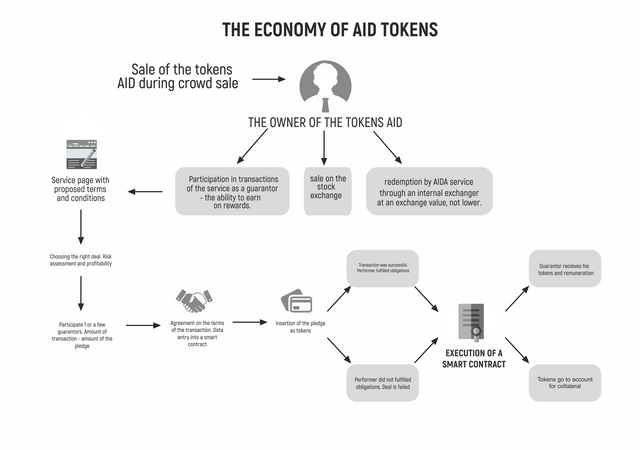Business model and finance of AIDA service - from CEO
In order for everyone to understand more how our service works I'll try to briefly outline and sketch out the business processes and business model.
Below is the actual scheme of the service, then the description for it.
 !
!
In order for the service to work, the manufacturers actually need to use the service and sell their product. The manufacturer is added to the system and passes a 3-step check https://steemit.com/service/@aidamarket/3-stage-counterparty-moderation-and-decentralization-in-the-aida-service, gets access to the private cabinet, where he is given the opportunity:
• Adjust the production pipelines, which can help you to create the prime price and production time according to their capabilities (information is displayed on the marketplace, depending on the specified quantity of goods in the order)
• Plan of the production by controlling the remain raw materials and finished products (in the private cabinet you can do pre-order of raw materials for the production warehouse)
• And also to form the price, export it and constantly be synchronized with the specialized marketplace of the service.
The customer will be able to choose the suitable product and the manufacturer, according to reviews about him and his rating in the marketplace. He can always see the actual information on the terms of production or the readiness to ship the order. This information is available through the synchronization of the marketplace with the personal cabinet of the manufacturer. You can also order delivery to the facility or to the temporary storage warehouse closest to it, for further consolidation and shipment. After payment, a smart contract is concluded for the distribution of funds between the executor of the order or fulfilment of other agreements.
Further, the availability of raw materials is checked, if it is empty or not enough, the producer pre order it (it is also planned to integrate warehouses of the raw material suppliers with the finished product producer). Further, the order goes into production and, upon readiness, is shipped to the production warehouse. Depending on the Customer's choice of the delivery method (as well as the ability to deliver the goods from the production’s warehouse), it is shipped or delivered to the customer or specified warehouse (customer's warehouse or temporary warehouse in the partner's service network). If the goods are already available in the warehouses of the service partners, the Customer can perform a self-delivery or request delivery to his facility.
The partners of the network will integrate into the service: warehouses and logistics companies. There are certain criteria for their connection to the service network. They are provided with service tools without a monthly fee, the service earns only by receiving 1% from the transaction that has passed through it. As a result of the delivery, all participants will be able to exchange electronically signed documents and reviews. Thus, the possibility of falsification of ratings and reviews is excluded, due to block chain technology. The overall rating is affected by the frequency of orders, the total amount of transactions and the average check that put the user's rating.
In the strategy for further expansion of the service, we focus on the timing of the preparation of the service in the regions on accounting and legal issues. We are almost ready to work in EURASEC. Service begins its work in the supply of construction materials, as there is understanding and experience in this market. After working out the business processes for production and supply, the range of goods will begin to expand (Furniture-Stationery-Clothing / Footwear-Equipment-FMCG). The sequence of expansion stages is chosen in connection with the volumes of markets and the similarity of business processes in models.
The financial part.
In addition to the information specified in the whitepaper https://docsend.com/view/qcxn8j4, I have attached a table with a feasibility study for this reference https://docsend.com/view/tif67w2. Looking at this table you can see the confirmation that the chosen business model is working, despite the lower commission level compared to competitors.
We have chosen a model for carrying out crowdfunding through the ICO, not for the purpose of quick earning. It sounds like an excuse, but still it really is. ICO gives us not only an opportunity to raise funds for development and marketing, but also to develop our community, to learn quick feedback from all over the world. With the help of this community, it is also possible to decentralize, give an opportunity to earn all participants. It is those who are the holders of our tokens who will be most interested in the development of the service, because the growth of the value of the tokens depends on this. The more such people in our campus will be the faster the service will develop. And marketing through the sarafan is very strong here. In this community, people who are more familiar with the technology of blocking, with its utility and capabilities. Therefore, it is also a channel for increasing education in these issues and reporting some of the values of the service.
The economy of tokens https://steemit.com/service/@aidamarket/mvp-introduction-and-economics-of-aid-tokens and their use in the service we painted in this article in more detail. It looks like this:

Schematic representation of the economy of tokens
In the previous article https://steemit.com/service/@aidamarket/start-of-the-new-standard-of-the-ico-message-from-our-ceo, I wrote about possible misunderstandings for the members of the crowdsdale on Hard Cap and Soft Cap, so we even decided on the site to indicate now that

thank you for explaining, some really consider holding an ICO just for the sake of profit)